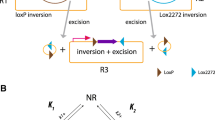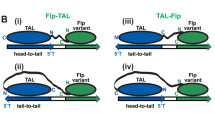Abstract
In a previous study, a recombination system based on the α complementation of cre recombinase and protein transduction was established. This system relied on the transient expression of the inactive, self-excisable C-terminal (β) and the transduction of the N-terminal (α) cre fragments to cells as a purified protein. This recombination system potentially results in a less invasive and more controllable cre recombination in mammalian cells. In this study, we have employed a more efficient complementation triggering sequence using more than only the overlapping amino acids to help the α and β fragments reassociate. In order to increase the association efficiency of the complementing fragments of cre recombinase, we chose to use a fusion of cre fragments to a self-heterodimerizing pair of proteins to trigger their binding and thus increase the efficiency of the restored enzymatic activity. For this purpose, the leucine zipper motifs (bJun and bFos) of the AP-1 transcription were fused to cre fragments (α and β, respectively). This resulted in an increased reassociation efficiency of the fragments and a two times more efficient recombination system compared with the previous study.




Similar content being viewed by others
References
Sauer, B., & Henderson, N. (1988). Proceedings of the National Academy of Sciences of the United States of America, 85, 5166–5170.
Nagy, A. (2000). Genesis, 26, 99–109.
Breckenridge, R., Kotecha, S., Towers, N., Bennett, M., & Mohun, T. (2007). Genesis, 45, 135–144.
Schmidt, E. E., Taylor, D. S., Prigge, J. R., Barnett, S., & Capecchi, M. R. (2000). Proceedings of the National Academy of Sciences of the United States of America, 97, 13702–13707. doi:10.1073/pnas.240471297.
Loonstra, A., Vooijs, M., Beverloo, H. B., Allak, B. A., van Drunen, E., Kanaar, R., et al. (2001). Proceedings of the National Academy of Sciences of the United States of America, 98, 9209–9214. doi:10.1073/pnas.161269798.
Silver, D. P., & Livingston, D. M. (2001). Molecular Cell, 8, 233–243. doi:10.1016/S1097-2765(01)00295-7.
Casanova, E., Lemberger, T., Fehsenfeld, S., Mantamadiotis, T., & Schutz, G. (2003). Genesis, 37, 25–29.
Jullien, N., Sampieri, F., Enjalbert, A., & Herman, J. P. (2003). Nucleic Acids Research, 31, e131. doi:10.1093/nar/gng131.
Seidi, A., Mie, M., & Kobatake, E. (2007). Biotechnology Letters, 29, 1315–1322. doi:10.1007/s10529-007-9406-6.
Glover, J. N., & Harrison, S. C. (1995). Nature, 373, 257–261. doi:10.1038/373257a0.
Hess, J., Angel, P., & Pchorpp-Kistner, M. (2004). Journal of Cell Science, 117, 5965–5973. doi:10.1242/jcs.01589.
Smeal, T., Angel, P., Meek, J., & Karin, M. (1989). Genes & Development, 3, 2091–2100. doi:10.1101/gad.3.12b.2091.
Xu, Y., Xu, G., Liu, B., & Gu, G. (2007). Nucleic Acids Research, 35, e126. doi:10.1093/nar/gkm559.
Ghosh, I., Hamilton, A. D., & Regan, L. (2000). Journal of the American Chemical Society, 122, 5658–5659. doi:10.1021/ja994421w.
Hu, C. D., Chinencov, Y., & Kerppola, T. (2002). Molecular Cell, 9, 789–798. doi:10.1016/S1097-2765(02)00496-3.
Author information
Authors and Affiliations
Corresponding author
Rights and permissions
About this article
Cite this article
Seidi, A., Mie, M. & Kobatake, E. Recombination System Based on Cre α Complementation and Leucine Zipper Fusions. Appl Biochem Biotechnol 158, 334–342 (2009). https://doi.org/10.1007/s12010-008-8409-7
Received:
Accepted:
Published:
Issue Date:
DOI: https://doi.org/10.1007/s12010-008-8409-7




